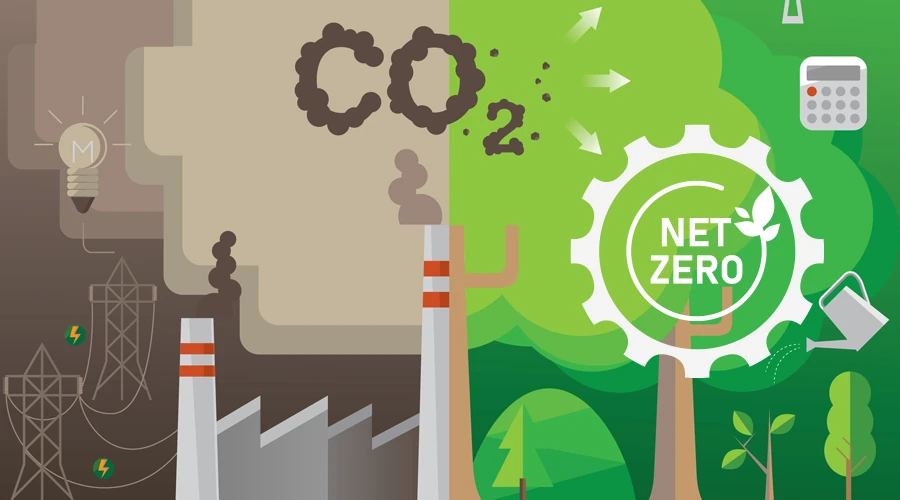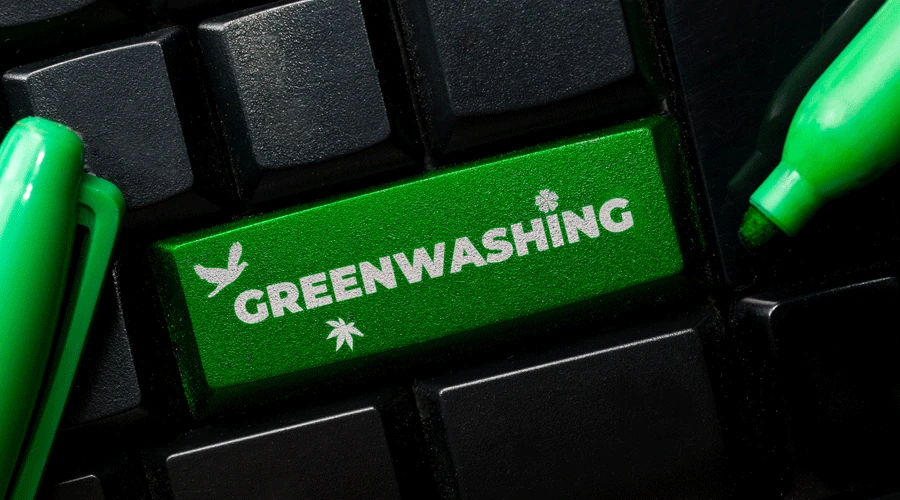Print is sustainable, isn’t it?
Printers have perhaps been a little quieter on the sustainability of the actual printing process itself,. but the green messages have been getting stronger in recent years. Many printers are keen to promote the fact that they use vegetable inks. The latest trend is to promote tree planting, carbon offsetting and carbon balancing.
However, in today’s increasingly climate-conscious environment where climate change is becoming a business priority, is the printing industry really doing enough?

Environmental messaging
has moved on
Many major organisations, including over 60 FTSE 100 companies, have already committed to being Net-Zero. And they are beginning to set themselves more challenging deadlines as well. In many cases, these targets are not about carbon offsetting or carbon balancing. There is now a firm emphasis on reducing carbon emissions through science-based reduction targets.
The brands are responding to consumer pressure. Siemens, for instance, plans to reduce energy usage at production facilities and offices, use low-emission and electric vehicles and move to renewable energy sources. It has reduced operational carbon emissions by 36% in the last two years and is investing heavily in carbon reduction projects. Another example is Brewdog. They are a controversial company, but, when it comes to carbon reduction, they have taken positive action. The company have installed anaerobic digestion and wind turbines amongst other strategies. They aim to reduce carbon emissions per hectolitre of beer by 35% versus its baseline in 2019.
There are not enough printing companies that can make comparable claims. Much of the industry is resting on its laurels and believes that its current messaging is sufficient.
But the drive to reduce emissions and carbon footprint is being backed up by legislation. The UK, the EU and the USA have all signed legally binding pledges to reduce carbon emissions. This is being backed up by more detailed legislation. For example, large UK companies must report on their carbon emissions of their buildings and vehicles under the UK government’s Streamlined Energy and Carbon Reporting requirements. The US government has gone one step further, and large federal suppliers are required to publicly disclose the carbon emissions in their entire supply chain.
Printing companies that stick to traditional environmental messaging will lose customers
The print industry story that seemed good a few years ago no longer stands up to scrutiny
Emissions from the pulp and paper sector stood at an all-time high in 2021. It is likely that the impact on climate change from the paper, printing and packaging industry is greater than that of what many may perceive as “bad” sectors such as aviation. This is especially true when full lifecycle impacts are considered: for instance, distribution and the greenhouse gases created when paper fibres degrade in landfill at the end of their life.
FSC accreditation sounds environmentally friendly. In reality, an FSC accredited printing company has had to do little more than show it can track paper correctly around a production facility. There are also questions around whether all FSC certified paper is as sustainable as the accreditation would suggest.
Vegetable inks also pose environmental questions, as they are manufactured from soy derivatives which contribute to deforestation.
Finally, carbon offsetting and carbon balancing sound great, but they do not represent the rapid and deep carbon reductions required. And not all schemes may be generating the claimed results. Recent investigations by The Guardian claim that more than 90% of rainforest carbon offsets by the biggest certifier are worthless.
Getting you to Net-Zero quicker with real science
We’re here to help you achieve your Net-Zero ambitions
Saying that print is sustainable is no longer true
It is now possible to obtain “carbon balanced” paper. This is typically achieved by making donations to organisations that are focussed on preserving forest. However, this does not require any reduction in carbon emissions. It simply ensures the preservation of forest areas that already exist. There are also new tree planting schemes but these trees will not start to absorb carbon for 30 years – doing little to solve the climate emergency.
It is important to preserve existing forests and plant new trees, and companies must keep funding this. However, without evidence of urgent carbon reduction it is becoming harder to use these third-party projects to claim that your business is sustainable.
In addition, it is not as easy to recycle paper as many people think. In many cases, paper has to be de-inked before it can be used in the manufacturing process again. Some types of ink may pose problems for the current de-inking processes. In the UK, Royal Mail is already advising against the use of flexo, aqueous and certain ElectroInks in its 2022 environmental guidance to customers.
To show the actual environmental impact of print, here is one example of the carbon footprint of a typical printed product:
An A4 96-page, litho-printed colour brochure with a four-page cover, with a run of 20,000 copies and a delivery distance of 129km creates a total carbon footprint of just over 20 tonnes (CO2e). This is equal to boiling a kettle 2.8 million times or flying over 4 times around the world in economy class.
Many in the printing industry would claim that their customers are happy with the status quo
However, this is no longer the case. As we have already seen, consumers are becoming more educated and demanding that their purchases have as low a carbon footprint as possible. The brands are responding to their demands. More and more brands are demanding science-based carbon measurement of their products and of their supply chains. This allows them to set carbon reduction targets and sustainable development goals. Print will have to play its part in this.
Relying on logos and certifications that sound good but don’t actually mean very much is no longer enough. The general public is becoming increasingly cynical at what some companies are doing. Greenwashing is affecting the image of many well-known major brands.
What should you do next if you want to become sustainable
Firstly, establish where you are at the moment. It is important to have a baseline to work from. Measure your emissions and the lifecycle carbon impact of the products that you are producing.
Next, set some targets. Some printing companies are already setting numbers-based targets on how they are going to reduce emissions.
Thirdly, create a roadmap on how you are going to arrive at your targets. Set key actions, estimate their impact and make sure you have dates to which you are committed.
With the right attitude and support, this can be done quickly.
We cover this in more detail in our blog here. One important point to note is that your action plan should be based on carbon reduction, not carbon offsetting. Carbon offsetting is already being treated with scepticism and printing companies need to show that they are making a real difference to their emissions. We write more about this here.
At the moment, it is hard to claim that print is sustainable
It doesn’t have to be this way. The industry has the potential to make a big reduction in its carbon emissions. However, it is time to take action rather than claiming that print creates environmentally friendly products.
PS Do you need help with measuring your emissions and developing a road map towards zero carbon? CarbonQuota is here to help. Talk to us here.
This calculation was taken from actual data measured from one of CarbonQuota’s clients. CarbonQuota achieves these calculations by taking the specification data of products such as the brochure in this example. Using its industry leading emissions factor database, it calculates the emissions associated with the production of each product, with a methodology consistent with the highest standards


